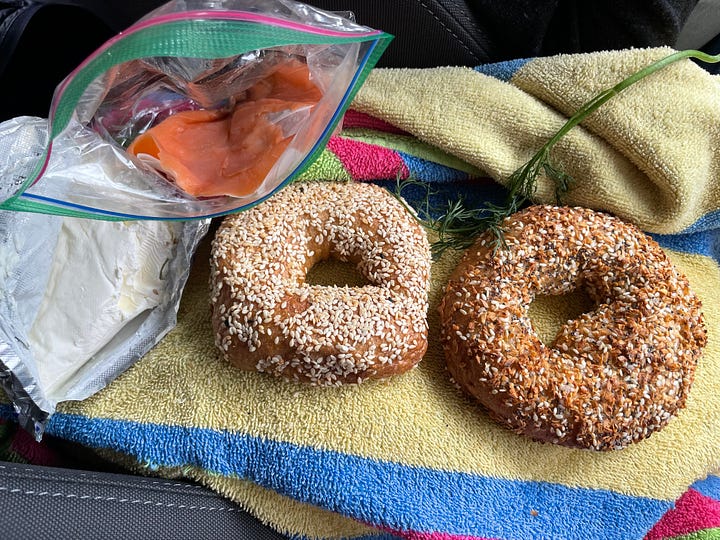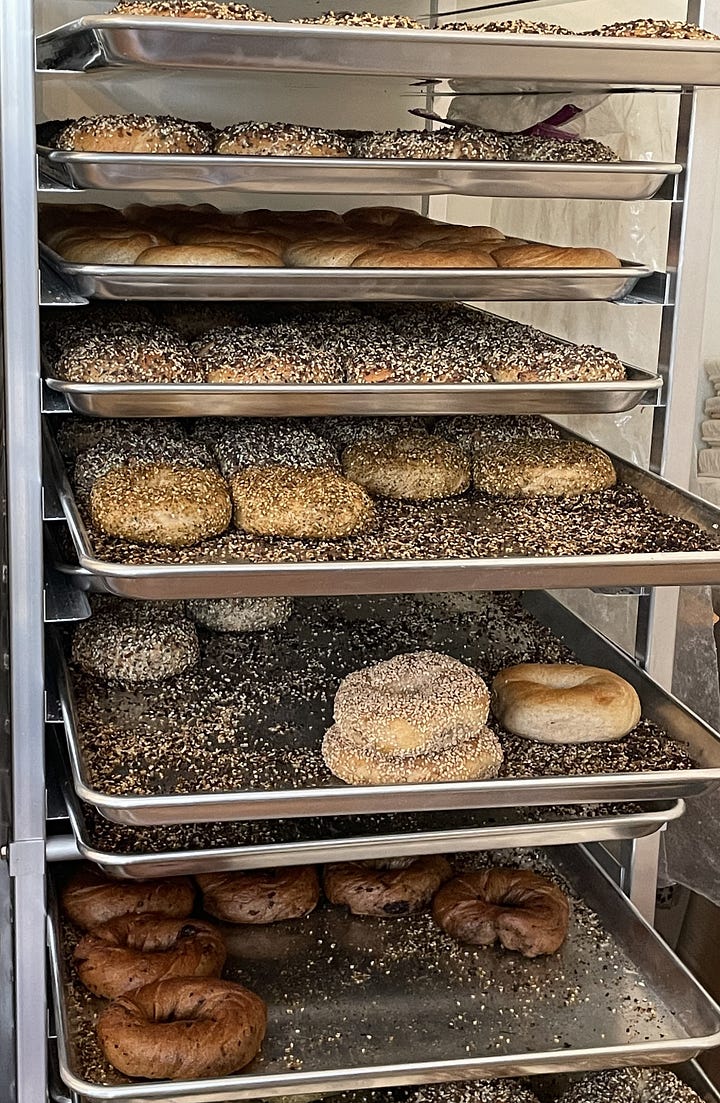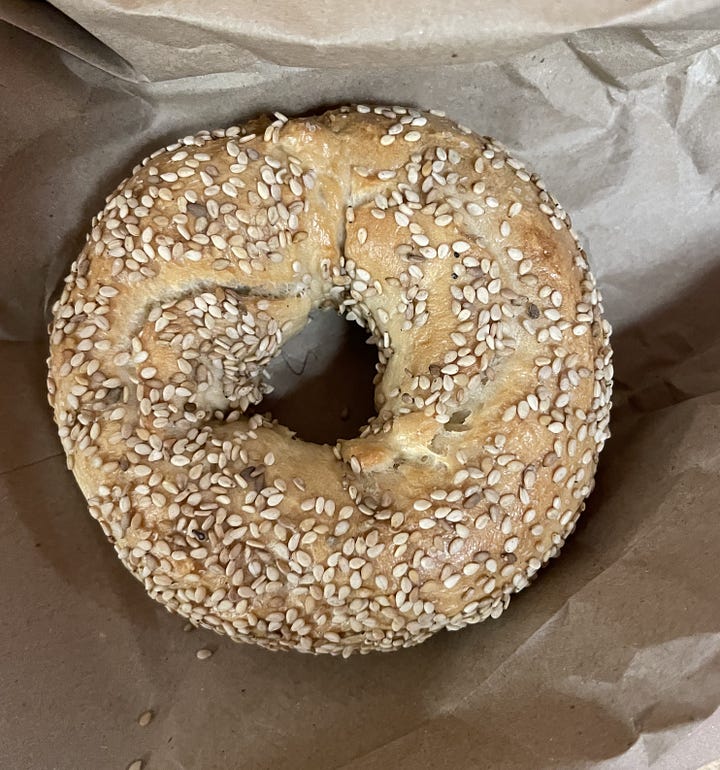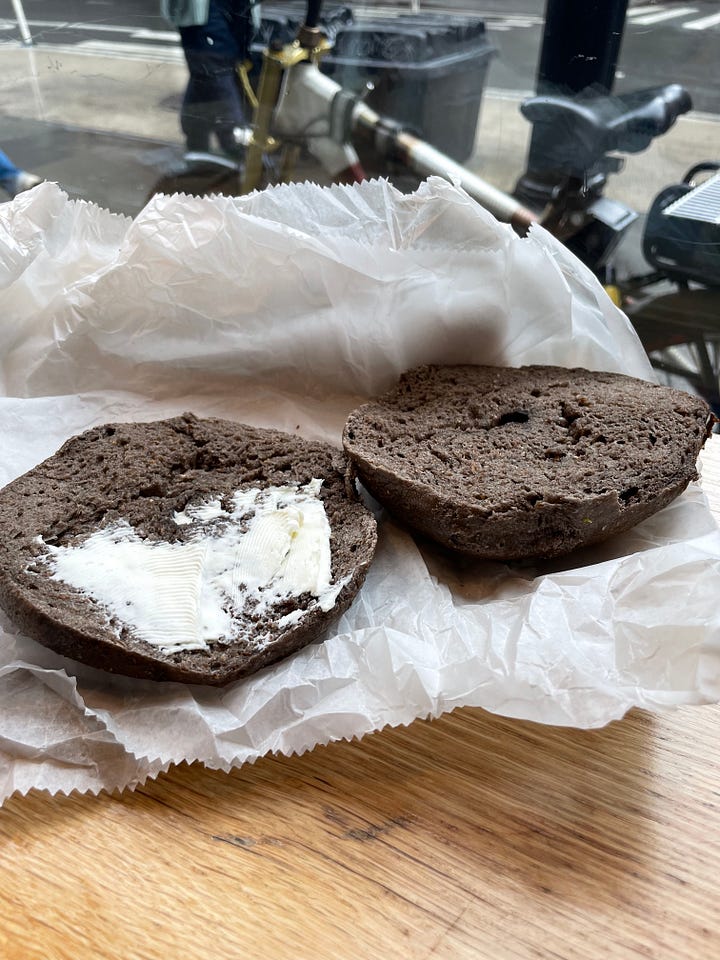The Oppenheimer of bagels
I think of the Thompson Bagel Machine as sorta the Oppenheimer of bagels, unleashing a technology that cannot be controlled. Yesterday I ate a NY bagel that proved my point.
Last April my son and I drove from Madison to Brooklyn to spend Passover with my family at my brothers house. I don’t mind this 16 hour drive on I90 to I80 to get from Wisconsin to NY, I have done it many times. Give me a book on tape, my favorite car snacks, a curated playlist and a fountain soda, and I am good to go. We pulled into the days Inn in Milan, Ohio after 11pm, and after a crappy night of sleep I dragged myself to the hotel breakfast buffet bright and early, where I was confronted with the worst looking bagel I have seen in a long time.
As I stared at this bagel while pouring the hotel’s milk in the bowl of cereal I traveled with, I thought about the Thompson Bagel Machine and all the trouble it started. Mickey Thompson grew up in England, the son of a baker. Sometime after WWI he built his first bagel machine in his workshop above a bakery. Years later his son invented the Thompson Bagel Machine, which the Lenders (of Lenders bagels) leased in 1963 and kickstarted the mass production of bagels, leaving us to be confronted with this truly terrible bagel. I wondered if Mickey, someone who presumably cared about the quality of his bagels, would care that he started in motion a process that led to the ability to churn out hundreds of bagels an hour, but they would all be substandard. Would he care that he was sorta the Oppenheimer of bagels, having unleashed a technology that cannot be controlled?


I spent most of yesterday at NYU’s special collections library looking through boxes of the Bagel Baker Union 338 archives. The union had been so dominant making NYC bagels that when they threatened to go on strike in 1951, the NYT’s headline was, Bagel Famine Threatens in City. (More about this iconic bagel union another day.) Now I know just enough about making bagels to make me a slightly dangerous narrator. But there simply are some essential elements to get the right balance of crisp exterior, interior chewiness, and flavor to make a NYC style bagel. Getting this right requires attention to how much flour you use in order for it to be a dense dough, how long you knead the dough, how much water you use, how you shape the bagel, how long you cold ferment it to give the bagel its more complex flavor, how long you boil it, and how you bake it. I offer this layperson's tutorial to say that if any of these steps are missing, it is not a traditional NYC style bagel. It can be a fine bagel, maybe a very good bagel, and possibly even a great bagel, although I have not found any anecdotal evidence to support that final point. But it is not a traditional bagel, the bagel where it all started and all the fuss has been made.
The vast majority of bagel eaters normed their tastes on bagels that were mass produced and do not taste like a traditional bagel. Which leads me to one of the documents I read in the NYU archives. A Study of Automated Technology: A Case Study of a Large Mechanized Bakery, commissioned by the U.S. Dept of Labor in 1956. The goal was to, “strive to design plants in which materials flow continuously from process to process without human intervention.” In this moment of AI and exploitative capitalism setting our public policy, this 1956 report was a reminder that there is truly nothing new under the sun. It is just on steroids now.


Reading through the study I realized the authors were talking about mixing machines and mechanized equipment that simulated hand operations that were developed in the late late 1800s, but Daniel Thompson didn’t start constructing the Thompson Bagel Machine until 1958. There were good reasons why that bagel didn’t easily lend itself to engineering machines of mass production. I will keep this short(ish) and focus on the bagel dough. The first of many blows to a great bagel was simply that the machines were not hardy enough to handle the dense quality of bagel dough. So water was added to thin out the dough which altered the chewy texture. More blow were to come but I will leave that for another day.
The upshot is that not great bagels are everywhere, even NYC. So when I left NYU to grab a quick lunch, and walked into the first bagel store I could find, I ate a very mediocre pumpernickel bagel. And while I would not have believed this at the start of my Midwest Bagel Quest, this NY bagel would not fare well against some of the delicious hand rolled bagels I found in the Midwest. (The unfortunate bagel is in the bottom right hand corner.)






